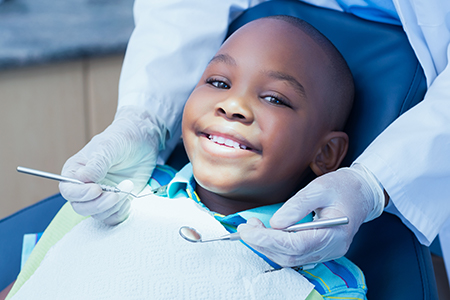
At the office of Fay Hu General Dentistry, we focus on guiding children toward strong, healthy smiles that support eating, speaking, and confident self-expression. Pediatric dental care is about more than quick appointments — it's a long-term partnership that helps children build good habits, prevents common problems, and supports proper growth and development from infancy through the teen years.

Early visits set the tone for a child's relationship with oral health. Gentle, routine checkups introduced during infancy and toddlerhood teach children what to expect and give parents practical strategies to maintain daily care at home. A calm, welcoming environment and staff experienced with young patients can make those first appointments positive experiences that encourage lifelong cooperation.
Prevention is the foundation of pediatric dentistry. Regular cleanings, fluoride where appropriate, and timely use of protective measures such as sealants help minimize the risk of decay while allowing the team to track how teeth and jaws are developing. When parents and clinicians work together, it’s much easier to catch small issues early and avoid more complex treatments later.
Every child is different, and care is tailored to age, temperament, and medical history. We prioritize clear communication with caregivers so you understand what to expect at each stage — from cleaning techniques you can use at home to milestones for erupting teeth. These conversations are practical and straightforward, aimed at making daily oral care manageable and effective.

Routine examinations are much more than a quick look inside the mouth. During a typical visit the clinician will review the child’s health history, assess the condition of teeth and gums, and evaluate how the jaws and bite are developing. This full-picture approach helps identify early signs of cavities, misalignment, or other concerns that benefit from monitoring or timely intervention.
Digital radiographs are used selectively when they provide information that can’t be gathered by visual exam alone. These images help the team see beneath the surface to evaluate developing permanent teeth, check for hidden decay, and confirm the health of the supporting bone. When radiographs are recommended, the information they provide guides safer, more effective care.
Professional cleanings remove plaque and buildup in places brushing may miss, and they are an opportunity to review brushing and flossing technique with age-appropriate instruction. Prevention-focused visits blend clinical care with practical education so children and their families leave with clear steps to protect oral health until the next appointment.
Tooth decay is the most common chronic childhood disease, but it is largely preventable. Decay develops when bacteria in plaque produce acids that break down tooth enamel. Young children can be especially vulnerable because their brushing skills are developing and dietary patterns often include frequent snacking or sugary beverages that increase risk.
Practical prevention strategies include establishing consistent brushing and flossing routines, limiting sugary and sticky foods, and encouraging water as the regular beverage choice. When appropriate for a child’s age and risk level, topical fluoride treatments and dental sealants provide an added layer of protection by strengthening enamel and shielding vulnerable chewing surfaces from decay.
Parents play a central role in prevention. Simple routines — supervising brushing, offering healthy snack options, and avoiding bottle or sippy cup habits that expose teeth to night-time sugars — make a measurable difference. Pediatric dental visits are a chance to review these habits and get personalized recommendations tailored to your child’s needs.
Begin dental care early by wiping gums after feedings and introducing a soft brush as teeth appear.
Brush with fluoride toothpaste in an amount appropriate for your child's age and assist until they have the dexterity to do a thorough job.
Avoid letting infants fall asleep with bottles of milk or juice to reduce prolonged exposure to sugars.
Keep regular dental checkups to monitor development and receive timely preventive care.
Set an example by modeling good oral habits and maintaining family routines for brushing and healthy snacking.
Choose water over sugary drinks, and balance treats with nutrient-rich foods that support growth and strong teeth.
Support the transition away from pacifiers and thumb-sucking at the age recommended by your clinician to prevent long-term bite changes.
Use a properly fitted mouthguard for children involved in contact or high-impact sports to protect their teeth and soft tissues.

A child’s first teeth begin forming long before they break through the gums, and many parents notice the first little teeth around six to twelve months. These primary teeth are essential for proper chewing, speech development, and holding space for permanent teeth. Because of their importance, early dental visits are recommended around the first birthday to establish care and answer practical questions.
Teething can be uncomfortable but is usually manageable with gentle measures. Cooling teething rings, soft gum massage, and distraction techniques often help. If concerns arise — such as prolonged fever, unusual swelling, or difficulty feeding — it’s appropriate to reach out to your dental team for guidance. Early contact helps prevent small concerns from becoming more serious.
As children grow, dental visits evolve from preventive checkups to age-specific guidance about sports protection, orthodontic evaluation, and independence with daily care. The goal is gradual, positive learning so children gain the skills and confidence to manage their own oral health when they’re ready.
Beyond cavities and cleanings, pediatric dental care tracks facial and jaw growth so that any developing issues are noticed early. Early observations can identify habits or growth patterns that may influence the alignment of permanent teeth. When needed, timely referral or intervention can simplify future orthodontic treatment and improve long-term outcomes.
Children’s facial structures and smiles change rapidly. Regular exams allow clinicians to evaluate bite relationships and jaw development and to recommend monitoring or treatment at stages when it will be most effective. Early guidance can include habit management, space preservation when a primary tooth is lost prematurely, and coordination with orthodontic specialists if appropriate.
Nutrition and overall health are integral to healthy development. A balanced diet supplies the vitamins and minerals that support strong teeth and bone growth, while reducing frequent sugary snacks lowers the chance of decay. Pediatric visits include practical nutritional advice tuned to a child’s age and activity level, so families can make choices that benefit both oral and general health.
Accidents happen, and active children sometimes experience dental injuries — from chipped or displaced teeth to soft-tissue cuts. Knowing how to respond can reduce the risk of long-term damage. For example, if a tooth is knocked out, quick steps to preserve it and prompt evaluation increase the likelihood of successful treatment. For all urgent concerns, a dental office can advise whether immediate in-person care is needed.
Painful toothaches, swelling, or signs of infection should be evaluated promptly to relieve discomfort and prevent complications. Pediatric dental teams are experienced in treating children in distress and focus on restoring comfort as well as addressing the underlying cause. Communication with parents is an important part of every urgent visit so that aftercare and prevention are clear.
Prevention remains the best protection. Properly fitted mouthguards, good home care, and attention to early warning signs all reduce the frequency and severity of dental emergencies. When families understand the basics of prevention and first response, they’re better prepared to protect their child’s smile during play, school, and daily life.
In summary, pediatric dentistry blends prevention, education, and timely clinical care to support healthy smiles as children grow. The practice at Fay Hu General Dentistry is committed to compassionate, evidence-based care that helps families feel informed and confident about the steps they can take every day. If you’d like to learn more about our pediatric services or schedule an appointment, please contact us for additional information.

A pedodontist is a dentist who has received advanced specialty training in meeting the dental needs of children from infancy to adolescence. Pedodontists, also referred to as "pediatric dentists," study child psychology, behavior management, caring for children with special needs, methods of handling oral/facial trauma, and various techniques for providing anesthesia and sedation. Pedodontists also understand the complexities of facial growth and development and have the clinical skills required to meet the dental needs of all children at every stage of development. Most of all, pedodontists are passionate about what they do and enjoy working with children. They strive to make every dental experience a positive one as they help children establish a strong foundation for good oral health.
Even before your child is born, their first set of teeth is already forming. In fact, by one year of age, some of your baby's front teeth will have already come into place. While the arrival of your baby's first teeth is only one of many developmental milestones, it represents an excellent time to begin a program of oral care. According to recommendations from the American Dental Association, babies should see the dentist around the time of their first birthdays.
Your baby's first teeth typically begin to appear in the 6 to 12-month range. While this is an extraordinary milestone, you need to be aware that your baby may find the experience a little bit uncomfortable. Teething can make babies feel irritable. They may be fussy, have trouble sleeping, not want to eat, and drool quite a bit.
Although you are powerless to speed up the process of teething, there are a few things that you can do to soothe your baby as the new teeth are erupting into place. Common approaches to helping your baby feel more comfortable while getting new teeth, include teething rings or a cold spoon or moist gauze rubbed over their gums.
Even for these few new teeth, it's absolutely essential to establish an effective regimen of oral care. For information on when your baby's first set of teeth will erupt into place, consult this timeline from the American Dental Association: Eruption Charts
Some children persist in sucking their thumbs or fingers beyond their preschool years. For these children, the activity continues to be a source of comfort, relaxation, and security. It may even help them fall asleep at night. However, it's essential to be aware that in the long-term, a finger sucking habit is not healthy.
If your child's thumb or finger sucking habit is still present when the permanent teeth begin to come in, your child is at a higher risk of developing a bad bite. By the age of five or six years, you need to constructively and gently help your child stop the habit.
It's also a good idea to have a comprehensive evaluation at this time. Your pedodontist can assess if there are any habit related alterations to the alignment of your child's teeth or jaws, or if it is affecting their speech or swallowing patterns. They can also discuss habit control strategies with you, as well as follow your child's bite and facial development as they grow. If interceptive appliances or corrective orthodontic care are recommended, the timetable and best options in care will be explained in complete detail.
The American Academy of Pediatric Dentistry and the American Dental Association recommend that a child see a dentist by their first birthday or within six months of the eruption of the first tooth. Early visits allow the dentist to check growth and development, identify risk factors for decay, and teach parents simple at-home care techniques. Establishing dental visits early helps children become comfortable with the office environment and sets the stage for preventive care.
During a first visit the dentist will perform a gentle exam of the mouth, assess feeding and oral habits, and provide guidance about brushing, fluoride, and nutrition. The team may demonstrate proper cleaning techniques and answer questions about teething and pacifier use. Follow-up frequency will be based on your child’s individual needs and risk for dental disease.
Before teeth erupt, wipe the baby’s gums with a clean, damp cloth after feedings to remove bacteria and sugars. Once the first tooth appears, use a soft, age-appropriate toothbrush with a smear (about the size of a grain of rice) of fluoride toothpaste and gently brush twice daily. Avoid putting a baby to bed with milk or juice and do not dip pacifiers in sweet substances.
As more teeth come in, supervise brushing and begin teaching flossing when adjacent teeth touch. Encourage drinking water between meals and limit sugary snacks to reduce decay risk. Regular dental visits will reinforce at-home care and allow the dentist to recommend additional preventive measures when needed.
For most children, routine dental checkups and professional cleanings every six months are recommended to monitor tooth eruption, remove plaque, and catch early signs of decay. Some children with higher decay risk, developmental concerns, or orthodontic appliances may need more frequent visits as directed by the dentist. Each appointment typically includes an exam, cleaning, and age-appropriate oral hygiene instruction.
The dentist will also assess growth of the jaws, the position of developing teeth, and whether radiographs are needed to evaluate areas not visible in the mouth. Based on these findings, the team will create an individualized schedule of preventive care, treatments, and follow-up appointments to support long-term oral health.
Dental sealants are a thin, protective coating applied to the chewing surfaces of permanent molars and premolars to block bacteria and food from settling into grooves and pits. They are typically recommended soon after these back teeth erupt, which is often during the early school years, because those surfaces are vulnerable to decay. Sealants are painless to place and can significantly reduce the risk of cavities on treated teeth.
The application involves cleaning the tooth, preparing the surface, and painting the sealant material onto the grooves; it then hardens quickly. Sealants should be checked at regular dental visits and can be repaired or replaced if they wear or chip. They are one part of a comprehensive prevention plan that also includes brushing, flossing, fluoride, and healthy diet choices.
Topical fluoride treatments delivered in the dental office are a safe and effective way to strengthen tooth enamel and help prevent decay when used appropriately. Professional fluoride varnishes or gels are applied during preventive visits and provide an extra layer of protection, especially for children at higher risk of cavities. The amount and frequency of fluoride recommendations are tailored to a child’s age, diet, and decay risk.
At home, parents should use a pea-sized amount of fluoride toothpaste for children over two years old and supervise brushing to minimize swallowing. Excessive ingestion of fluoride over long periods can cause dental fluorosis, so it is important to follow dosing guidance from your dentist or pediatrician. The dental team will review both professional and at-home fluoride use to ensure safe, effective protection.
In a dental emergency remain calm and assess the situation quickly; for a knocked-out permanent tooth, find the tooth, handle it by the crown, rinse gently with water if dirty, and attempt to place it back in the socket or store it in milk or saline while seeking immediate dental care. For chipped or fractured teeth, save any broken pieces and contact the dental office for prompt evaluation to reduce the chance of further damage or infection. Severe pain, swelling, uncontrolled bleeding, or a tooth that has been pushed out of position also warrant urgent attention.
If the injured tooth is a primary (baby) tooth, do not attempt to replant it; contact the dentist to determine the appropriate next steps. For deep cuts to the lips or soft tissues, control bleeding with gentle pressure and see dental or medical care as directed. The dental team can advise whether an office visit, emergency clinic, or hospital care is necessary based on the type and severity of the injury.
Nonnutritive sucking is a common soothing behavior in infants and young children and typically does not cause lasting dental problems if it stops by the preschool years. However, prolonged thumb sucking or pacifier use beyond ages 3 to 4 can alter the position of the teeth and shape of the jaws, potentially affecting bite alignment and speech. The degree of impact depends on the intensity, frequency, and duration of the habit.
If a sucking habit persists into the early school years, the dentist can assess any developing changes and recommend behavior strategies to help the child stop. Interventions include positive reinforcement, habit awareness tools, and, when necessary, referral for orthodontic evaluation to plan corrective treatment. Gentle, consistent guidance from parents and dental professionals is often effective in helping children transition away from these habits.
The American Association of Orthodontists recommends that children have an orthodontic screening by age 7 so early growth patterns and bite issues can be identified. By this age some permanent teeth have erupted and the orthodontist can detect problems such as severe crowding, crossbites, or abnormal jaw growth that may benefit from early or interceptive treatment. Early evaluation does not mean every child needs braces at that time, but it allows for timely planning and monitoring.
If early intervention is recommended, targeted treatments can guide jaw growth, preserve space for permanent teeth, or reduce the complexity of later orthodontic care. For many children, comprehensive orthodontic treatment occurs during the adolescent years when most permanent teeth are present. The pediatric dental team will coordinate with orthodontic specialists to determine the appropriate timing and type of care for each child.
Preventing cavities begins with limiting exposure to sugary liquids and sticky foods and establishing good oral hygiene from the start. Parents should avoid putting babies to bed with bottles containing milk, formula, or juice, and should offer water instead; prolonged exposure to sugars increases the risk of dental decay in the front teeth and throughout the mouth. Regular brushing with fluoride toothpaste, as appropriate for the child’s age, and supervised flossing when teeth touch are essential daily habits.
Routine dental visits allow the dentist to assess risk and recommend preventive measures such as fluoride varnish or sealants when indicated. Encouraging a balanced diet rich in whole foods, offering water between meals, and limiting snacking frequency also reduce caries risk. Education and consistent home care are the most effective tools parents have to protect their child’s smile.
Pediatric dental care should be individualized to meet a child’s emotional, developmental, and medical needs, and many practices use behavior guidance techniques such as tell-show-do, distraction, and positive reinforcement to create a comfortable experience. For children with heightened anxiety, sensory sensitivities, or special health care needs, the dental team will discuss pre-appointment planning, shorter or staged visits, and accommodations to reduce stress and improve cooperation. Communication with caregivers and, when appropriate, the child’s medical providers helps ensure safe, coordinated care.
When behavior guidance is not sufficient, the dentist may review additional options such as nitrous oxide or other forms of sedation, always considering medical history and safety. Parents should share relevant health information, current medications, and prior dental experiences so the team can develop a tailored plan. At the office of Fay Hu General Dentistry in Winter Park the goal is to provide compassionate, evidence-based care while maintaining a focus on safety and comfort for every child.

We are dedicated to providing the highest quality of dental care to our patients.
Through excellence in dentistry and quality in relationships, we strive to positively impact your oral health, aesthetics, and self-esteem. From the front desk to the treatment room, our experienced team is here to support you with expert care and genuine compassion.